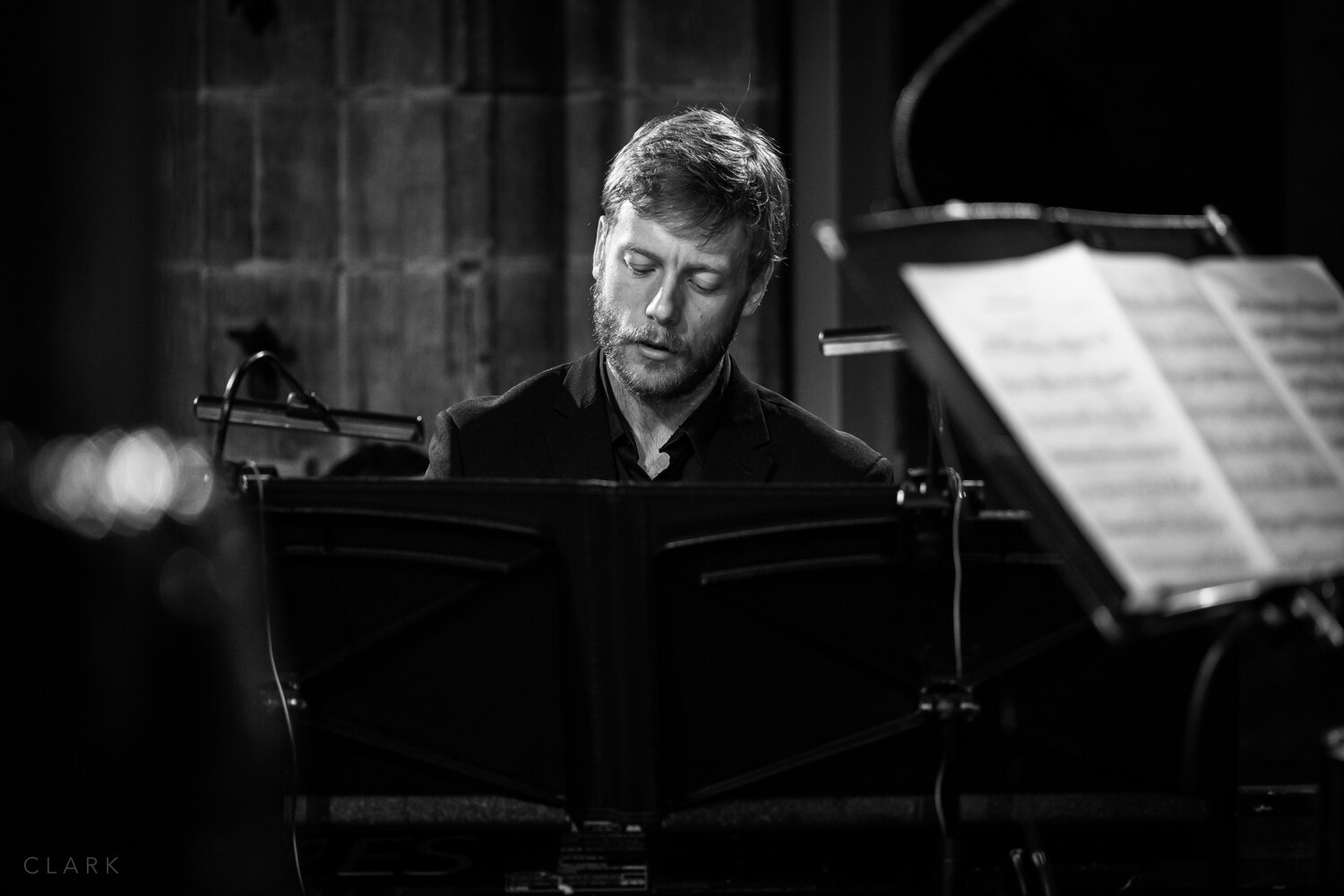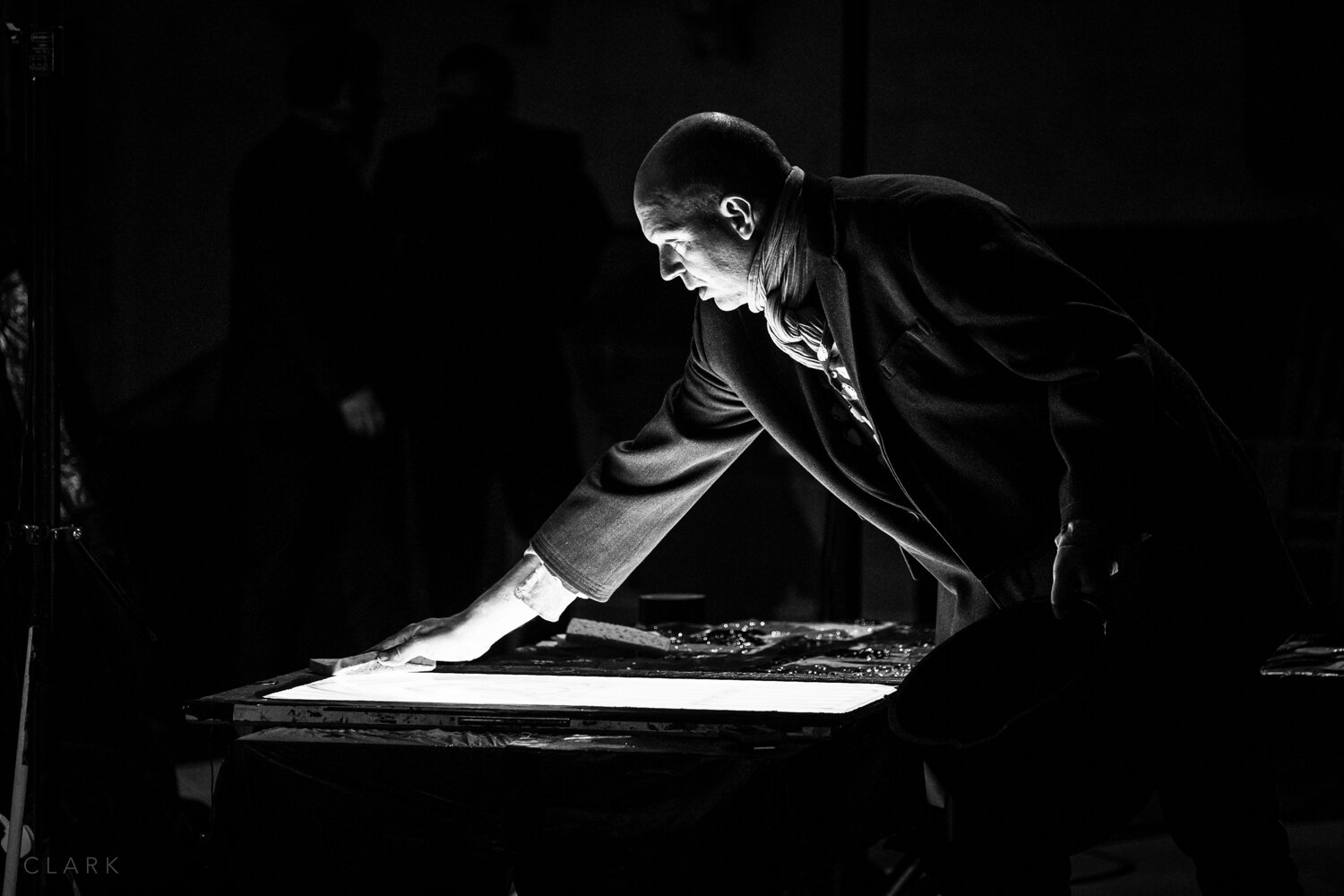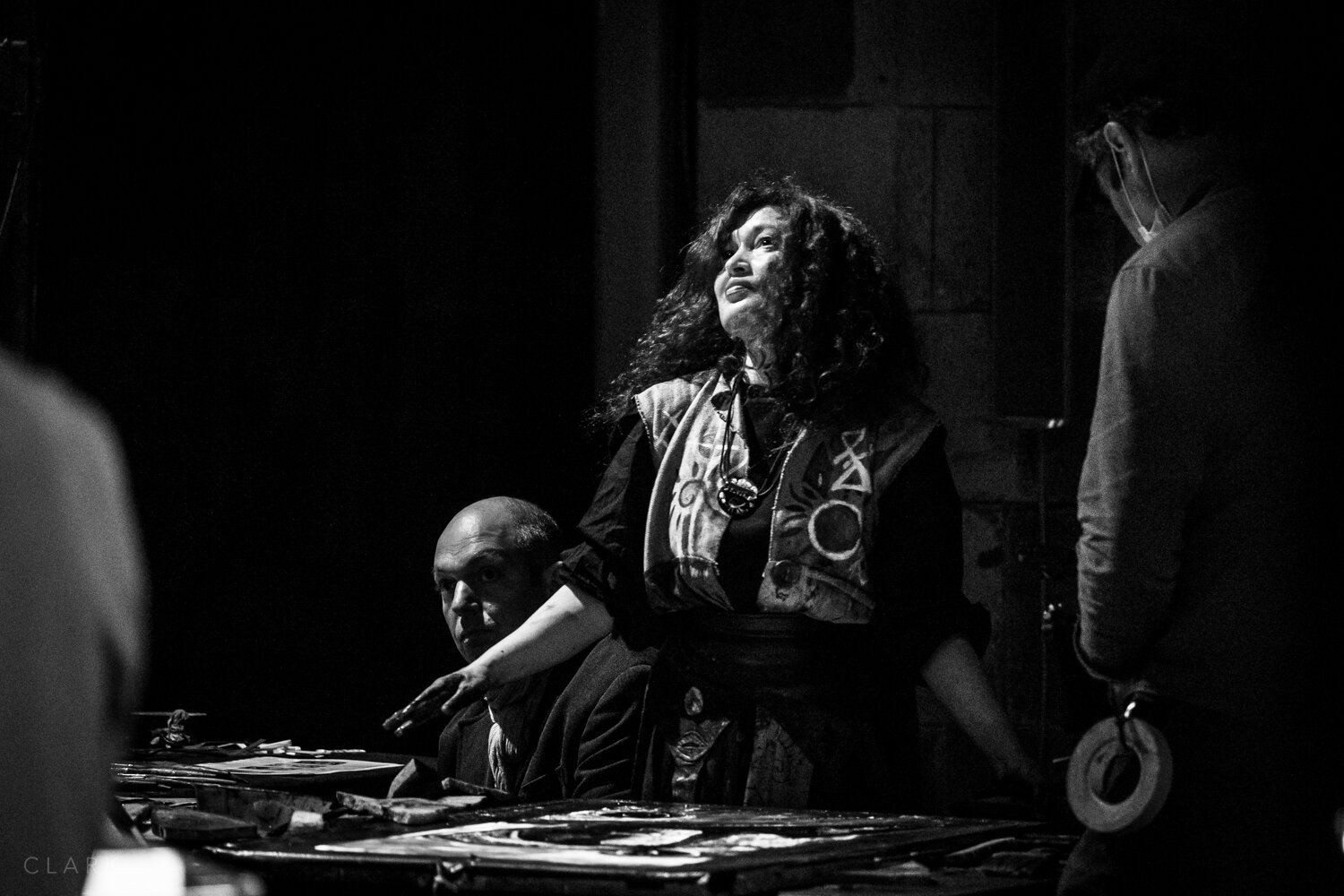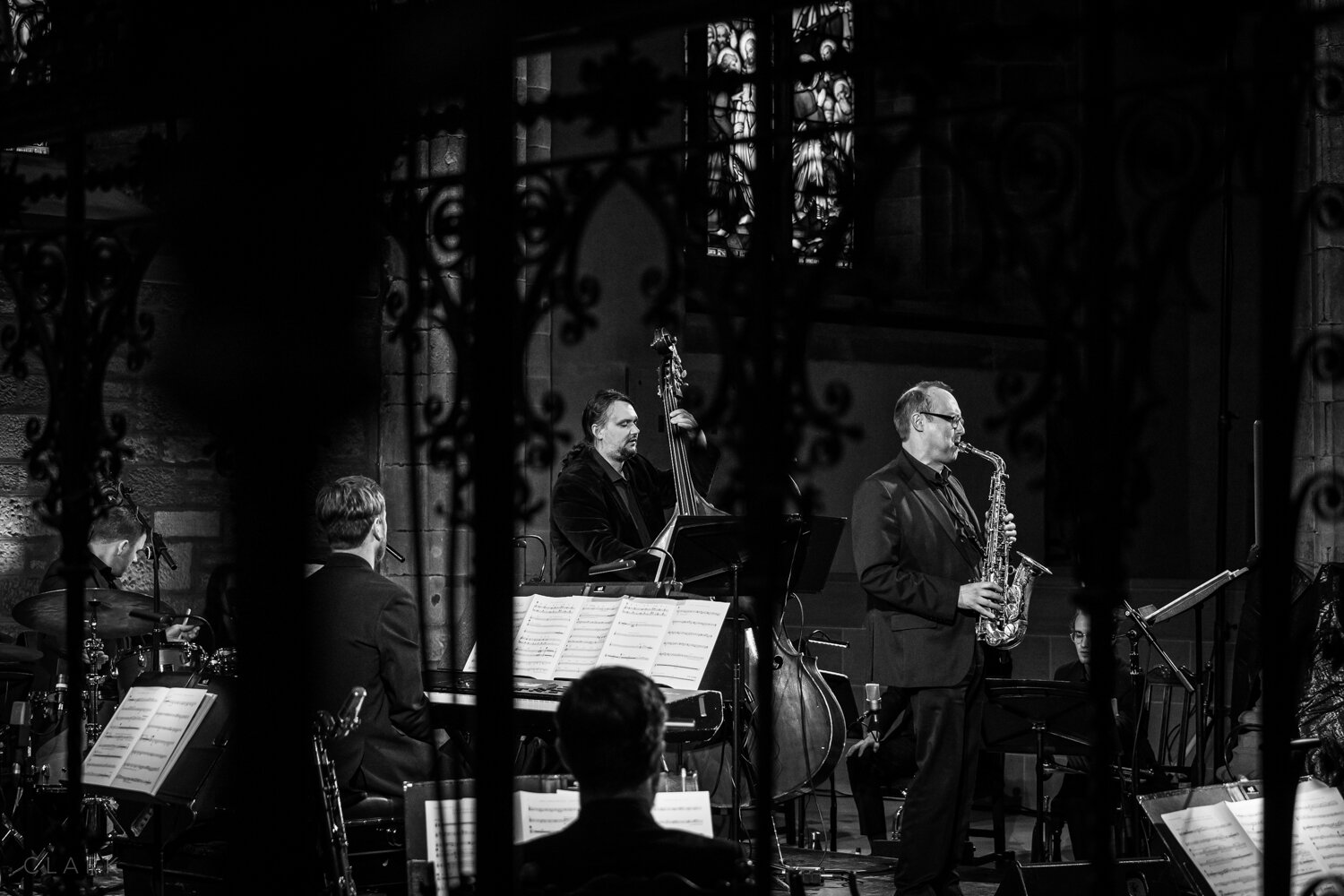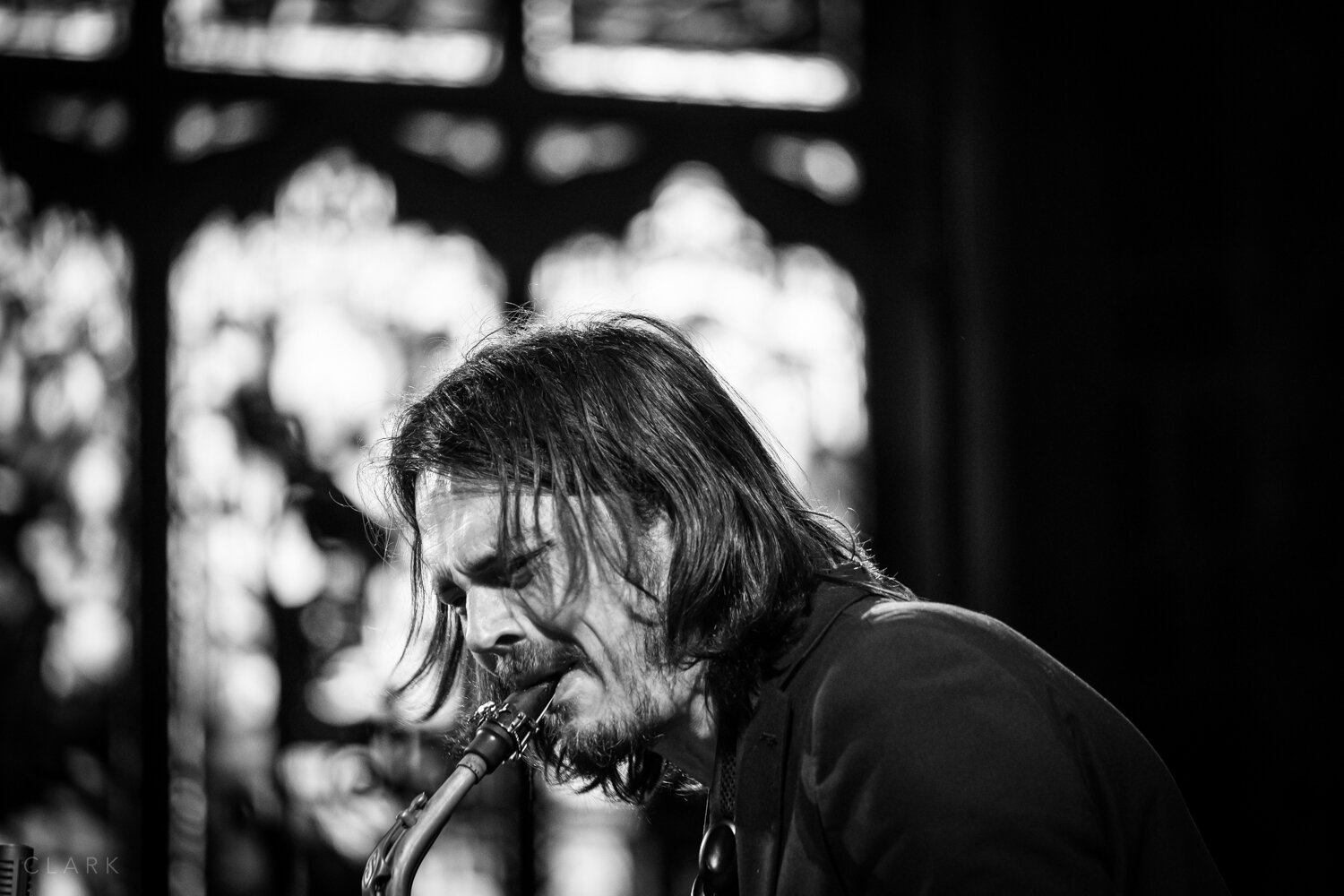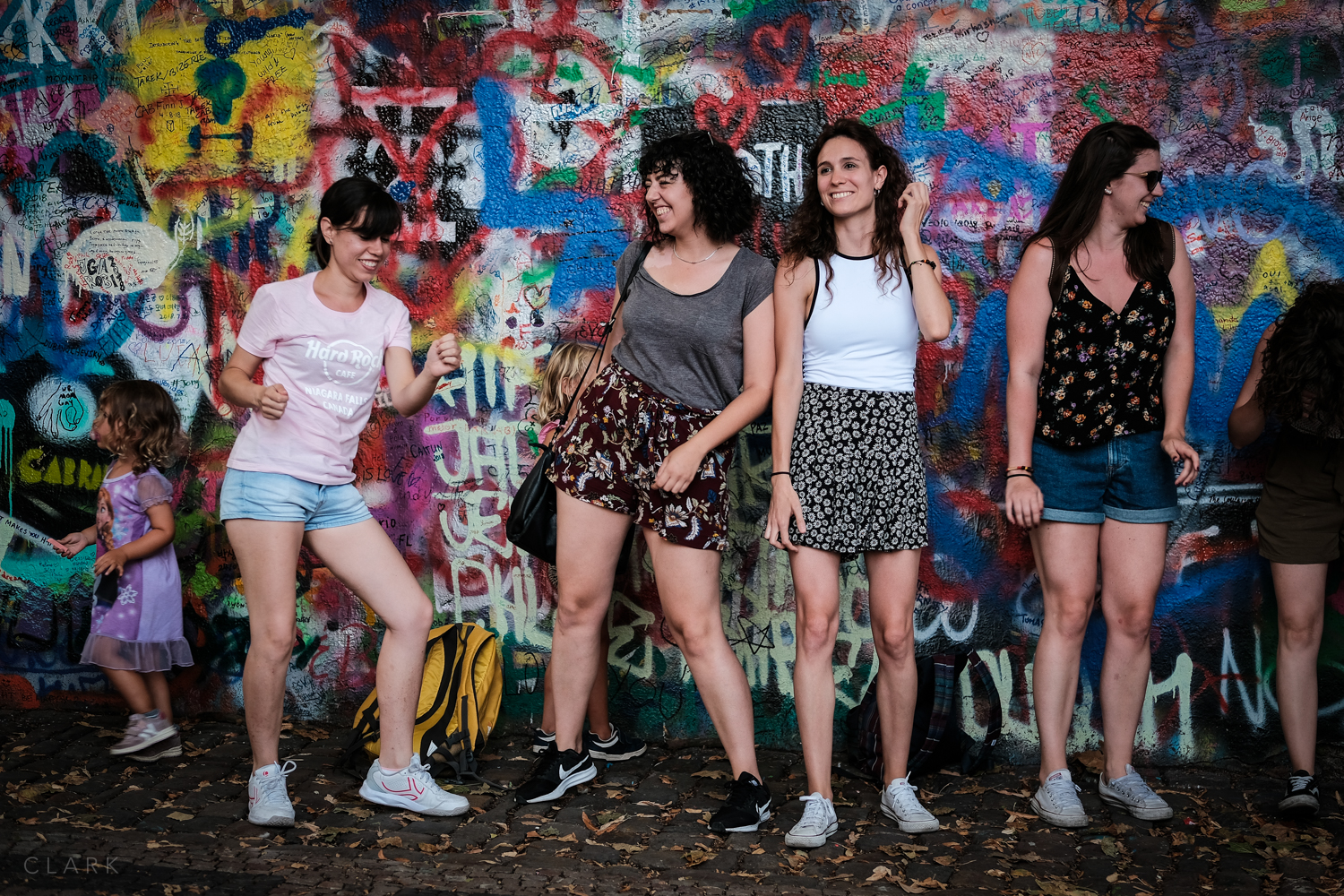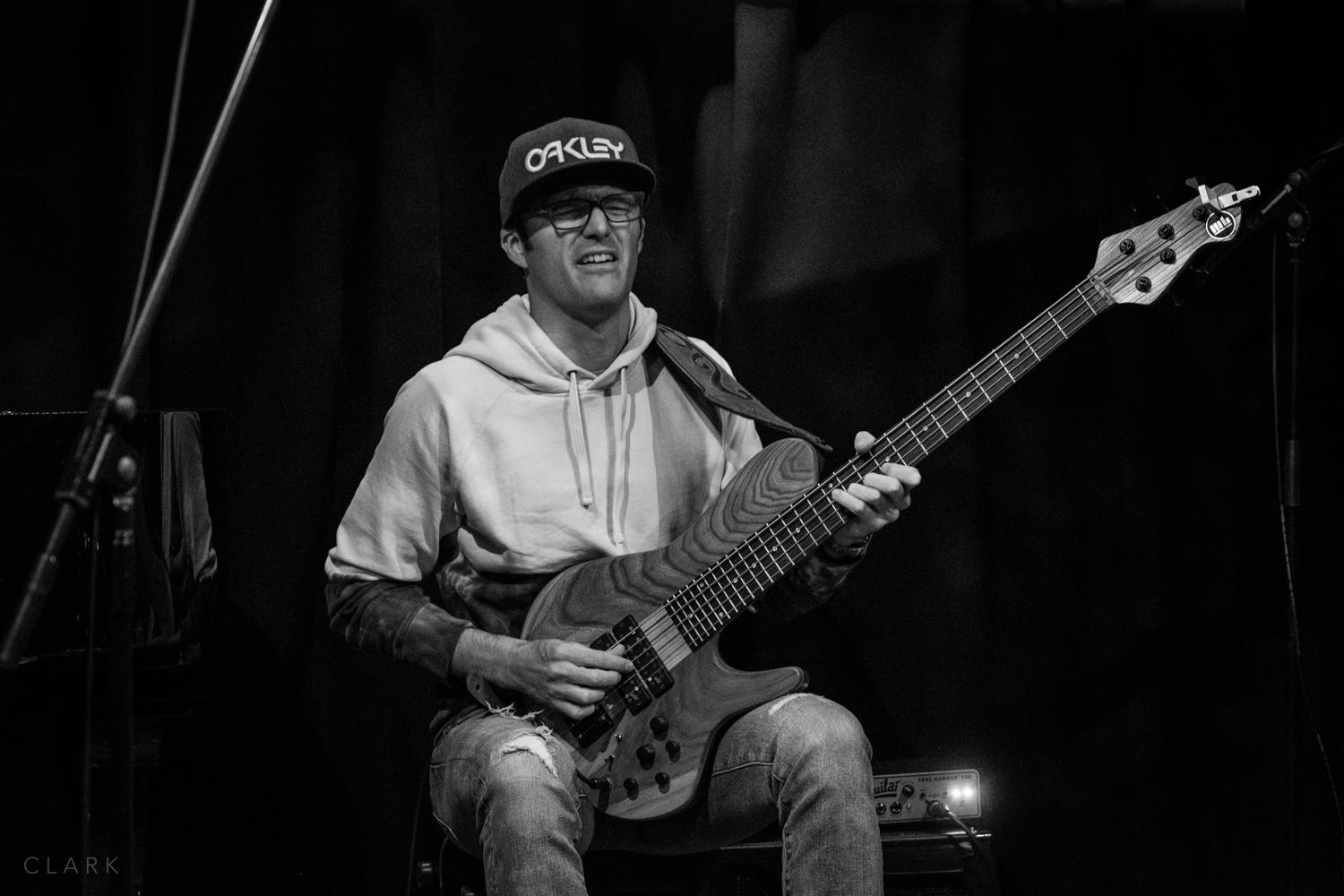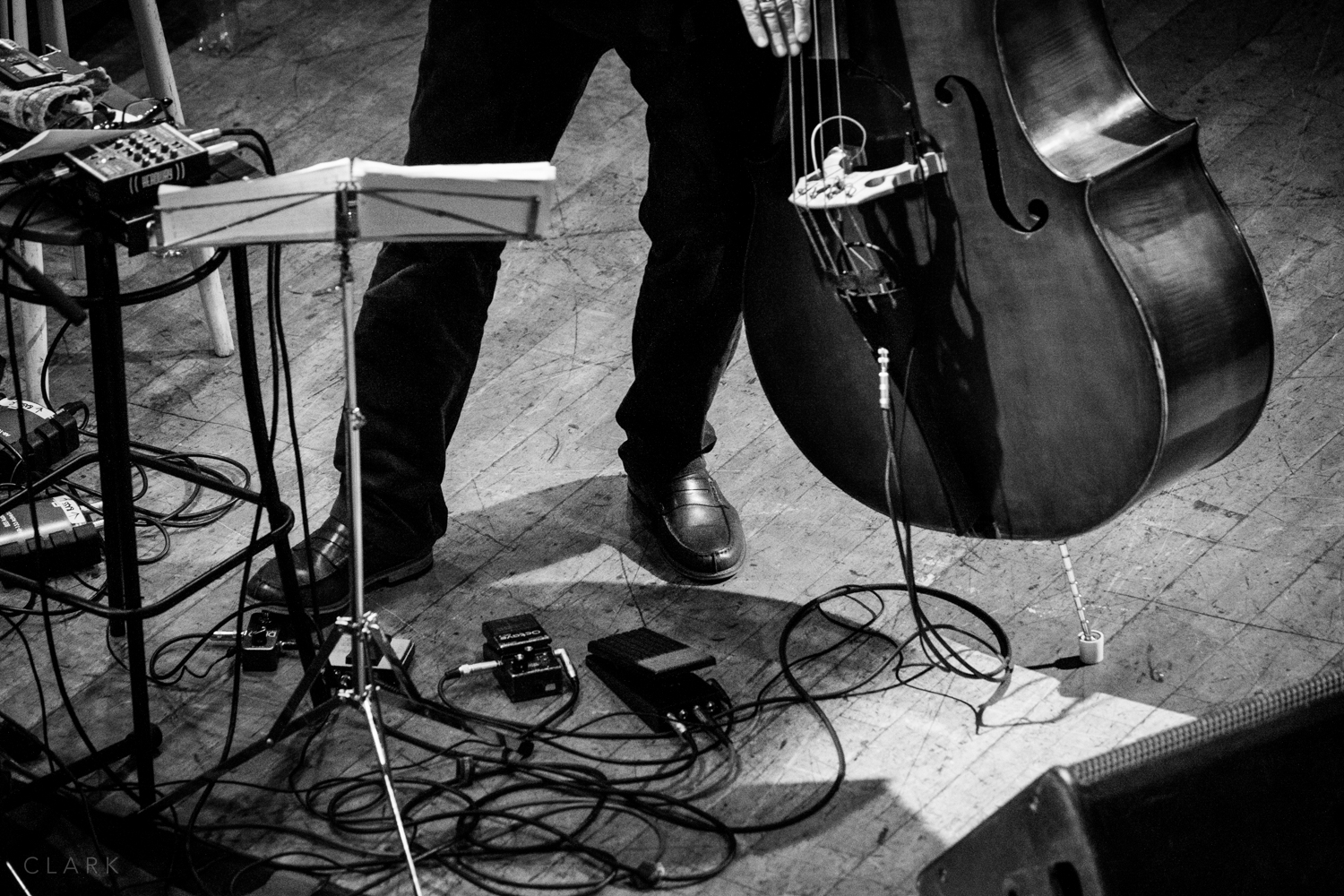
BLOG
Where Rivers Meet: The Synergy Of Art And Music
Almost two weeks ago, I photographed a very special concert by The Scottish National Jazz Orchestra at the stunning St Giles Cathedral in Edinburgh (Scotland) called 'Where Rivers Meet'. The concert features artist Maria Rud painting live to the music of some great composers. The art was then projected onto the stained-glass windows of the cathedral.
The concert features four suites by the SNJO, which will go out on the internet over four consecutive nights and feature soloists Tommy Smith, Konrad Wiszniewski, Paul Towndrow and Martin Kershaw.
Go to livestream.snjo.co.uk to experience the visual and sonic world of WHERE RIVERS MEET from St. Giles Cathedral in Edinburgh.
12th May 7:15 PM
ORNETTE COLEMAN / MARIA RUD / PAUL TOWNDROW
music arranged by Tommy Smith
13th May 7:15 PM
DEWEY REDMAN / MARIA RUD / KONRAD WISZNIEWSKI
music arranged by Paul Towndrow
14th May 7:15 PM
ANTHONY BRAXTON / MARIA RUD / MARTIN KERSAHW
music arranged by Paul Harrison
15th May 7:15 PM
ALBERT AYLER / MARIA RUD / TOMMY SMITH
music arranged by Geoffrey Keezer
Maria Rud’s art created live and projected onto the stained-glass-windows of St Giles Cathedral, Edinburgh
In-camera double exposure
Fujifilm Framing Outline Feature
As a music photographer I often have trouble seeing where the edge of the frame is inside my viewfinder while shooting in dark venues. I often have pictures where my subject’s head is just touching the top of the frame where I thought I had allowed headroom.
So I was delighted when I found (by accident) a feature that is in the X-T2, X-T3, X100F, X100V, and I’m sure all the latest cameras. It’s called ‘Framing Outline’ and it puts a grey outline around the frame on both the electronic viewfinder and the rear LCD screen. Here’s where to find it.
SET UP - SCREEN SET-UP - DISP. CUSTOM SETTING - 'FRAMING OUTLINE (usually the last on the 4th page). Just make sure that’s ticked and you will see an outline on your frame.
This is not just a great feature for those of us shooting in dark music venues, but for portraits against black or dark backgrounds or any kind of night shooting. Give it a try and leave a comment below if you find this useful.
What's In A Music Photographers Bag
I sort of fell into the genre of music and over the last seven years, I’ve shot more than 300 artists and taken more than 50,000 pictures as a music photographer. I shoot all types of music, but mostly jazz. I am currently the official photographer for the Scottish National Jazz Orchestra (SNJO) and my pictures have been featured on album covers, tour posters and magazine publications. At the time of writing this post, I am putting the finishing touches on a book featuring the last 7 years with the SNJO.
THAT WAS THEN
There was a time when I shot Nikon alongside my Fuji’s, but with the release of the Fujifilm XF50-140mm f2.8 my D800 (amazing camera) ended up staying at home, and after six months or so of no use my full Nikon kit was sold. I also used a Lowepro backpack for a long time, but as I often have to pull my camera back out of the bag just as I am about to leave a venue, a shoulder bag is the way I go these days (mostly).
THIS IS NOW
These days I am using a Domke F2 (black canvas) bag. It’s not a massive bag, but it’s not small either. What I can fit inside the F2 is about as much weight as I want to carry and as it is packed full, I have to take out a lens if I want to include a different one. This works well for me as I would end up carrying way to much gear otherwise. If I know I’ll be shooting a lot of backstage pictures I might wear my belt-pack to the gig and put an X-Pro2 body in one of the side pockets as I prefer a rangefinder-style body for that sort of shooting.
SIDE POCKETS
Starting at the F2’s side pockets. I have a BlackRapid Yeti double harness strap, a Manfrotto Pixie mini tripod and a Spider Holster in one pocket, and a small pouch that attaches to my belt in the other pocket.
BLACK RAPID YETI
The BlackRapid strap takes up a lot of room and I have thought of getting rid of it and using regular straps many times, but this harness works well and is easy to adjust quickly for one camera or two.
SPIDER HOLSTER
The Spider Holster is rarely used but can be handy when using a third camera. I keep the spall spanner/wrench in my belt pouch for attaching the little stud to the bottom of the camera.
BELT POUCH
These tactical pouches are available on Amazon for very little money and are essential for what I do. I put this on my belt as soon as I arrive at the venue and it saves me from having to get to my bag (which can be at the side of the stage) for essentials. I keep a notebook, pens, spare batteries, SD cards, business cards and a lens cleaner in this. It also has a section on the outside for my iPhone, which I insert upside down, face inward (and muted) so that it doesn’t light up on its own.
LOWEPRO PADDED WRAP
I have had this green Lowepro padded wrap, that came with another bag, for years. It is folded like an envelope and mostly just lies on top of my gear as the F2 doesn’t have any padding. I keep an iPad mini in the zippered pocket on the lid of the F2, which protects the screen on the back of my camera, but the wrap is just added protection. It can also come in handy for kneeling on or a number of other uses.
INSIDE THE BAG
FUJIFILM X-T2 AND XF 16-55mm F2.8 WR
The Fujifilm XF 16-55 f2.8 lens is attached to my X-T2 most of the time and this the camera and lens combo that I keep handy at the top of my bag so that I can pull it out or put it back in the F2 easily. It sits in the bag with the lens facing down. This comes in handy when leaving a venue as I often have to pull a camera out for a few shots, or if I keep it out it means I can slip it back in at the venue door without needing to remove the bag from my shoulder. Something the backpacks are not functional for.
THE FUJIFILM X-T3
The amazing 50-140 f2.8 lens is my concert workhorse. It can’t fit in the Domke attached to my X-T3, so the camera body fits inside the F2 square insert. These inserts are divided into 4 sections for lenses, but unlike the older versions that were sewn, the newer ones have Velcro so the section can be adjusted to take the X-T3 with the battery grip attached. This also creates a space for my Zoom H1 audio recorder (more on that later). I attached a spare Billingham Velcro insert above the X-T3 that acts as a hinge and folds over to protect the X-T3 and X-T2 from bumping into each other.
SWITCHABLE LENS
Still on that square Domke insert (this one is included with the F2). I have the 23mm f1.4 lens in the photo above, but this is where I keep my switchable lens. By switchable, I mean that if I need to bring another lens, it will go in here and the 23mm will stay at home. This stops me from carrying too much equipment and weight (more on these extra lenses later).
Front pocket contain audio equipment (left) and white balance tools & business cards (right)
LENSES
I have a 16mm f1.4 and a 56mm f1.2 stacked in a tall square Domke insert I bought on Ebay. I use the JJC square metal lens hood on both these lenses (and the 23/1.4), so they can be stacked safely as they have flat plastic caps. I highly recommend these lens hoods. They are equal in quality to the Fuji optional ones, but less expensive.
The 50-140mm f2.8 workhorse lens sits inside a Domke insert that comes with an F-4AF bag. This insert is a bit wider and has the space required to include the tripod mount on the lens. I attach the BlackRapid strap to the tripod mount instead of the camera as the weight of this heavy lens would put too much strain on the camera’s lens mount.
NISSIN i40 FLASH
I rarely use flash for music photography (never ever for shooting during a concert), but sometimes I might need to use it for a backstage portrait if the light is really bad. The Nissin i40 is small and slips in the F2 between the sidewall of the bag and the smaller of the lens inserts. It sits in there and I forget about it until I need to remember. The i40 runs on 4 AA batteries and has enough power for anything I need on a music shoot. If I am required to shoot promotional portraits or promo shots, I will take a bag full of Yongnuo YN560 IV’s, stands and modifiers. But that’s another story.
AUDIO EQUIPMENT
After being asked to shoot some after-show video clips and interviews without any notice, then having to cobble a less than ideal setup to get by with, I now always keep a small audio kit with me. You have already seen where I keep the Zoom H1 inside the main compartment of the F2, and the Manfrotto Pixie that can be used as a tabletop tripod for shooting video. I use one of the front pockets to store a Rode lav microphone and extension cable (including an adaptor to allow it to fit the X-T3 or my iPhone). I also have a set of Apple earbuds for monitoring sound and a spare 3.5mm to 3.5mm cable that can be used to attach the Zoom H1 to the X-T3’s headphone socket. So I can record audio in camera, lav mic to Zoom H1 or both at the same time.
WHITE BALANCE
The other front pocket of the F2 is used for business cards and white balance tools. I have a Color Checker Passport, ExpoDisc and a set of white balance cards on a lanyard. Overkill? Perhaps. I also use this bag for portrait shoots so the Color Checker is invaluable.
OPTIONAL LENSES
The three lenses that I often swap out when needed are the 12mm f2.8 Samyang, the Fuji 10-24mm f4, and the awesome Fuji 90mm f2. These lenses all have their use, but it can often depend on the venue or the job. For instance, The 12mm Samyang is useful if I can get on stage behind a band or orchestra and shoot toward the audience.
CARDS AND CLEANING
I also take a JJC SD card holder (stored in with the white balance tools) and both the RocketBlower (F2 side pocket) and a Lens Pen. I also have a lens cloth in my belt pouch. I don’t use lens caps so like to clean my lenses before a show.
iPAD
It’s not shown in the photos, but I also keep an iPad Mini inside the zipped pocket in the top lid. I often send a couple of pictures during the interval from a camera to the iPad using the built-in wifi feature. I edit these using Snapseed and then send them to the client so they can be used on Facebook to promote the following night’s performance. It saves me having to do it when I get home.
Lowepro CompuTrekker 350 backpack, Domke F2 and the Domke F-1x
OPTIONAL BAGS
If I really must take extra gear I can use the larger F-1x (bottom right in the picture above) which can hold a massive amount of gear but can get too heavy. Or I might opt for the LowePro Computrekker 350 backpack if I’m travelling by train and have a long walk to the venue.
A FEW LAST TIPS
Always have more than one camera.
Always have at least one camera with a lens attached in your bag.
Always keep spare batteries and cards on your body.
Use a belt bag or pouch to carry your spares and phone.
Make sure you get a photo pass from the venue or the client.
Lock in your white balance, it will save you hours of editing time later.
Shoot completely manual. I tend to shoot at f2.8, /125th of a second and adjust my ISO using the front command wheel.
Clean lenses before a show.
Sync camera clocks before the show (see below if you forget).
Make sure you have enough space on SD cards for the full show.
SYNCHRONISING CAMERA CLOCKS AFTER THE SHOOT
It is crucial to synchronise the clocks on all cameras used on a shoot. It’s always better to do this before the gig, but it’s very easy to forget. So here is a method I use when I get home. I use a world clock app called ClockZ which constantly updates the time and is extremely accurate.
Shoot a photo on each camera of your phone while it displays the world clock time.
Ingest all the pictures from your shoot into Lightroom.
Press G on your keyboard to enter Library Module Grid Mode.
Click on Metadata above your pictures.
In the camera section, choose one of your cameras.
Now go to the last picture you shot (which should be the one of your phone).
Click on that picture.
Hold down Command (Ctrl on Windows) and press A on your keyboard to select all.
Now ho to the Metadata menu at the top of your screen and choose Edit Capture Time.
Make sure ‘Adjust to a specific time and date’ is checked.
Input the time & date from the picture of your phone into the ‘Corrected Time’ section.
Click ‘Change’. It will warn that this can’t be undone but don’t worry about that.
Now repeat the process for your other cameras and all your pictures will be in sync.
If you have found this post helpful and you are thinking of buying any of the gear I use? You could help me out (at no cost to yourself) by buying from Amazon UK using the links below. Thanks.
Yuri Goloubev: Two Chevrons Apart
Back in May last year, I was shooting pictures for my labour of love jazz book that I have been working on for four years now. It’s a slow process and I feel lucky when I get to shoot a single great jazz musician for the book. But on the 12th of May 2019, I struck gold with three great musicians. The Tim Garland Trio featured the bandleader on tenor and soprano sax, Jason Rebello on piano and Yuri Goloubev on bass.
I arrived early and set up my background and lights for the portraits. One camera was ready with a trigger on the hot shoe and a second camera was set for the wide-angle documentary shots that were needed. The band arrived and one by one I shot the pictures needed. Yuri told me about a new record he was working on and that he needed some pictures for the CD. We sorted out the details and I told Yuri I would send him some pictures.
I stayed to shoot the gig and it was such a fantastic performance by all three musicians. The venue was The Merchants House in Glasgow and it was a spectacular setting for the tight acoustic trio. A few days later I send Yuri the pictures and then forgot about it. Until a couple of months ago when Yuri got in touch to tell me the CD would be coming out on the 17th of April 2020, but he wanted to send me a pre-release copy. Sure enough Jiffy bag showed-up in the post a few days later.
The CD will be released and sold by Basho Records and is available by clicking the link at the bottom of this page. Two Chevrons Apart was recorded at Artesuono Studios, Cavalicco, Udine, Italy and engineered by Stefano Amerio, and what an amazing job they have done. Yuri is joined by Tim Garland on soprano and tenor saxophone, John Turville on piano and Asaf Sirkis on drums. Each musician adds precisely the right ingredient to this simmering pot of delicious jazz. Now and again the heat is turned up but then settles back down to simmer, keeping you hungry for more.
Do your ears a favour and pick up a copy of this great album. It will be available from Basho Records from April 17th 2020 by clicking the button below.
John Lennon Wall
Tucked away in a small part of Prague known as Kampa Island, you will find The John Lennon Wall. A place where many flock to for reasons known only to them. Some come to look, others come to add to the graffiti. But most it seems, come to take selfies. It's a strange old world! **Click on the pictures below to see larger versions.
Bob Reynolds
I recently had the pleasure of photographing saxophonist Bob Reynolds for a book I've been working on for some time now. The book is about jazz musicians and without giving too much away at this stage, it's a mixture of portraiture, documentary and some live performance stuff thrown in for good measure. At this point in time, the project is solely funded by me, which keeps the progress at a steady pace due to the cost of travel and accommodation.
Bob was currently on his European tour to support his latest CD called Quartet, so I reached out to him as he has been on my hit list for a while. Manchester was the preferred date, which suited me fine as it's only a three and a half hour train journey from where I live in Scotland. A journey that turned out to be really great on the TransPennine, with stunning scenery on a lovely sunny day. I love to travel by any means of transport, so the journey is part of the enjoyment.
After arriving at Manchester Piccadilly station, I headed for the hotel (via The Real Camera store to drool over a couple of tempting Leica's (M6 and M7). Credit card still intact and a little lump in my throat, I had lunch at the hotel before making my way to the oddly named venue Band On The Wall to meet Bob and the band.
After the usual meet and greets, I set up my small traveling portrait rig, including two light stands three flashguns, a trigger, and two double-fold umbrellas. The weak part of this travel portrait rig is the background. None of my Lastalite/Manfrotto collapsible backgrounds fold small enough and I can’t find a small headshot background to suit anywhere. So I'm using a small collapsible reflector that my friend John Summers gave me and I clamp a piece of black velvet material to it. It's a bit time consuming and doesn’t look very professional. But it gets the job done
With the portrait shots complete, we went downstairs and I made a few documentary-style pictures in the dressing room as Bob selected a batch of possible reeds for that night's gig. I moved around the room, making sure I had plenty of variety in my shots, changing angles, shooting from a low angle, getting something in the foreground, shooting into mirrors etc. I was shooting in RAW+JPEG but I shot a few B&W JPEG's to let Bob see a few pictures on the back of the camera to give him an idea of how they might look.
After a quick trip back to my hotel to drop off my lights and stands etc, I headed back to the Band On The Wall to shoot the gig. The venue was packed so I had limited space to move around and switched from primes to a couple of zooms for that reason (24-85mm and 75-210mm in 35mm terms, both f2.8). It wasn’t the brightest venue I've shot in, so 1/125th sec at f2.8 meant my ISO was around 3200 for the centre of the stage and anywhere between 6,400 and 12,800 for the sides.
The gig was very special in my opinion. The energy between musician and audience was something that you don’t always get with jazz gigs, and it was great to see a younger generation of jazz fan so enthusiastic about the music. Bob also plays in the band Snarky Puppy and obviously has a following that includes quite a few Snarky fans as well as his own fan base, which is no doubt expanded with the popularity of Bob's highly addictive vlog on YouTube.
Pianist Oli Rockberger dept for Ruslan Sirota on the first few gigs of the tour as Ruslan was busy being the best man at his friends' wedding, but Oli played as though he had been a part of the quartet for years (he and Bob went to Berkeley at the same time). Most of the tracks on Quartet are pretty laid back, so it was great to see Chaun Horton being able to let rip on the drums on some really funky numbers, which were made all the funkier with Janek Gwizdala on the bass. Janek also has a great vlog on YouTube, which is based on the bass (see what I did there), but like Bob’s vlog, is enjoyable to both musicians and non-musicians. Janek is a joy to watch on stage. His bass playing is extraordinary and his use of effects pedals is a lot of fun, especially when a looper pedal is involved.
But the last word has to be on Bob. A fine musician/composer with an equal gift of a warm fat tone on the tenor sax with a great technical ability. One minute you’re listening to a beautiful ballad on the bottom end of his Selmer Mk VI and the next you’re being bombarded with amazing altissimo dexterity that makes the hair on the back of your neck stand up.
Bob is exactly what you see on his vlog, a really nice guy with a lot of time and respect for others. This shoot was a real pleasure.
Fujifilm X100F: Tommy Smith - Return To The Mausoleum
I was honoured when the good people of Fujifilm asked me to be part of the Pre-Production testing of the new X100F camera. As a documentary photographer, I've been working on a long term Jazz project for the past 3+ years which has gained a bit of attention recently. It also seemed like a good subject for this X100F assignment, which I had to produce still photographs and a short film.
STEVEN HAWKES
Rather than bring someone up from the south all the way up to Scotland, I suggested to Fuji that I would make the video in partnership with my good friend Steven Hawkes. An interesting fact is that I met Steven because of the original X100. I had reviewed the X100 on my blog and posted many pictures and articles. So when Steven searched the internet looking for information on the camera before he bought one, he found my website. But instead of using the comments section or emailing me, he decided to use the phone. It turned out we were only a few miles from each other, so I asked if he would like to see the camera in the flesh and we met for a coffee. He did buy the X100 after that and we stayed in touch and became really good friends, meeting for coffee often and even going out shooting now and then.
Steven also has a health obsession for video and shoots corporate promo films, so he was the obvious choice when it came to shooting the X100F film.
TOMMY SMITH
Tommy is a jazz saxophonist, composer, band leader and educator. He is Head of Jazz at The Royal Conservatoire of Scotland and has a list of accomplishments that defy his age. Without Tommy, my jazz project would probably never got off the ground. I was honoured to have been part of his recent composing and recording project with the BBC Scottish Symphony Orchestra, producing pictures for the CD and even on the front cover of Jazzwise magazine.
When I told Tommy that I wanted to make a film based around jazz for a pre-production camera, he planted the seed in my brain to use The Hamilton Mausoleum as the location. I had been thinking more about one of Tommy's gigs, but the Mausoleum was a terrific idea. Tommy has a connection with this iconic building as he recorded an album called 'Into Silence' many years before. The building has one of the longest reverbs in Europe and that made it the perfect place for a solo saxophone piece.
HAMILTON MAUSOLEUM
I contacted the extremely helpful folks at The Hamilton Mausoleum the next day and got things rolling. I wasn't sure if I could hire an iconic building like this, but I did and it didn't break the bank either. Even before there day of the hire, Steven and I would meet outside the Mausoleum and shoot all the external scenes that feature in the film. It was winter and frosty outside. We froze our asses of during these shoots, but it was Tommy who suffered the most for our art.
On the day of the shoot, the interior of the Mausoleum was colder than it was outside. I was like being in a fridge and Tommy wore a suit and a pair of leather shoes. I also play saxophone, so I can testify that when it's cold, a sax is not an instrument you want to be holding! Tommy's feet and hands must have been extremely painful for the two hours we kept him there, but he's a pro and didn't complain once.
EDITING THE FILM
Editing proved to be a difficult job. Unlike a regular video edit where you cut to a piece of music used in the background, Tommy played live, so what you see and what you here are from the same shoot. Editing to live music is filled with many problems. But I think Steven and I pulled it off and we're both happy with the results. But the most important people I hope are pleased with the film are of course Fuji and Tommy. Steven and I set out to make something a little different from the average promo film. We think we have, but the viewers will decide.
Turin Brakes
A few pictures of Turin Brakes performing at Belladrum (Tartan Heart) Festival, near Inverness, Scotland last weekend. I didn't even know the band were on the bill until just before their set, but they were fantastic! It's hard to believe that such a powerful sound comes from just a four piece band of two guitars, bass, drums.
shot with the X100T and the X-Pro2 with the 35mm f2 or 56mm f1.2
Related Links
Arild Andersen Trio
Last week I had the pleasure of photographing The Arild Andersen Trio during the Scottish leg of their current tour. The Trio consists of Norwegian bassist and composer Arild Andersen, Scottish tenor saxophonist Tommy Smith and Italian drummer Paolo Vinaccia. Although Paolo is Italian, he has actually lived in Norway for the last couple of decades. I photographed a gig at The Queen's Hall in Edinburgh and then again a few nights later when they played a private gig for a the music students at The Royal Conservatoire of Scotland which is located in Glasgow, where Tommy is Head of Jazz. The picture at the top of this post was shot with my trusty Fuji X100T using the daylight balanced florescent lighting on the ceiling of the room. The picture has a slight crop to straighten it up a little, but other than that it's straight out of camera. All other pictures were taken with a couple of X-T1's.
If you haven't seen or heard this trio and you like jazz, I would highly recommend you do so as soon as possible. With beautiful compositions and double bass from Arid, not only that, his use of effects and loops help expand the normal constraints of a trio. Paolo's drumming and percussion is unique and he can take the band from a whisper to a full out onslaught and then back again. He can produce sounds from a cymbal that I have never heard from any drummer and on top of that he's a really nice guy that knows his cameras. Last, but definitely not least is Scotland's jazz legend Tommy Smith, fresh from receiving The Houses of Parliament jazz award for teaching. Tommy is a world class saxophonist and composer who has created a thriving jazz scene in Scotland and is largely responsible for the talented crop of young jazz musicians coming up today.
I've also been shooting some pictures for Tommy's next CD with the BBC Scottish Symphony Orchestra. More about that coming up in the next couple of months.
GIG AT THE QUEENS HALL IN EDINBURGH (Above)
PRIVATE GIG FOR THE MUSIC STUDENTS AT THE RCS GLASGOW (Above)
Get In The Loop With A New Ebook
If you enjoy shooting music, or if you haven't tried it yet and don't know where to start, Flemming Bo Jensen has the answer. Flemming launches his new ebook available now called 'Get In The Loop - How To Make Great Music Images' and man is it worth the money! At 220 pages long and only $6.99 (USD) it's a no brainer. Flemming has done a first class job on the layout too, which makes it a really enjoyable read that's packed with information on how to do music photography.
Get In The Loop is also under the banner of Kage Editions which is our Kage Collective publications side. I know that Flemming has slaved over this ebook for many months, with a lot of help in the editing department from Charlene Winfred (our Singaporian Kage member).
So as it's comming up for Christmas and you know you need something informative to read, why not download Get In The Loop. Then feed your brain and maybe start a personal project in 2016 on shooting music with what you learn? If you're still not convinced, try reading my post on the Kage Collective site titled The Value Of A Personal Project.













